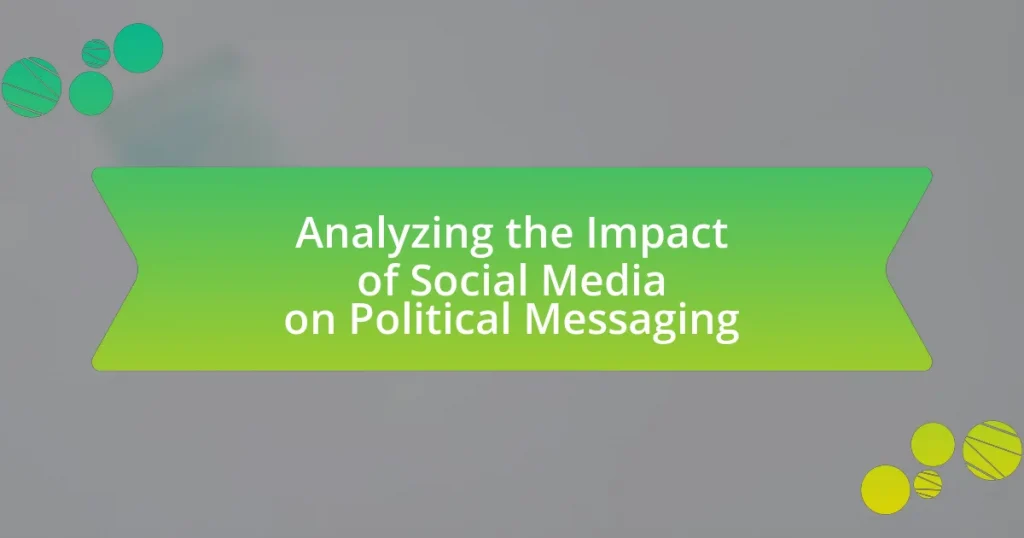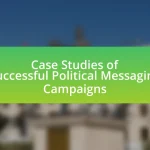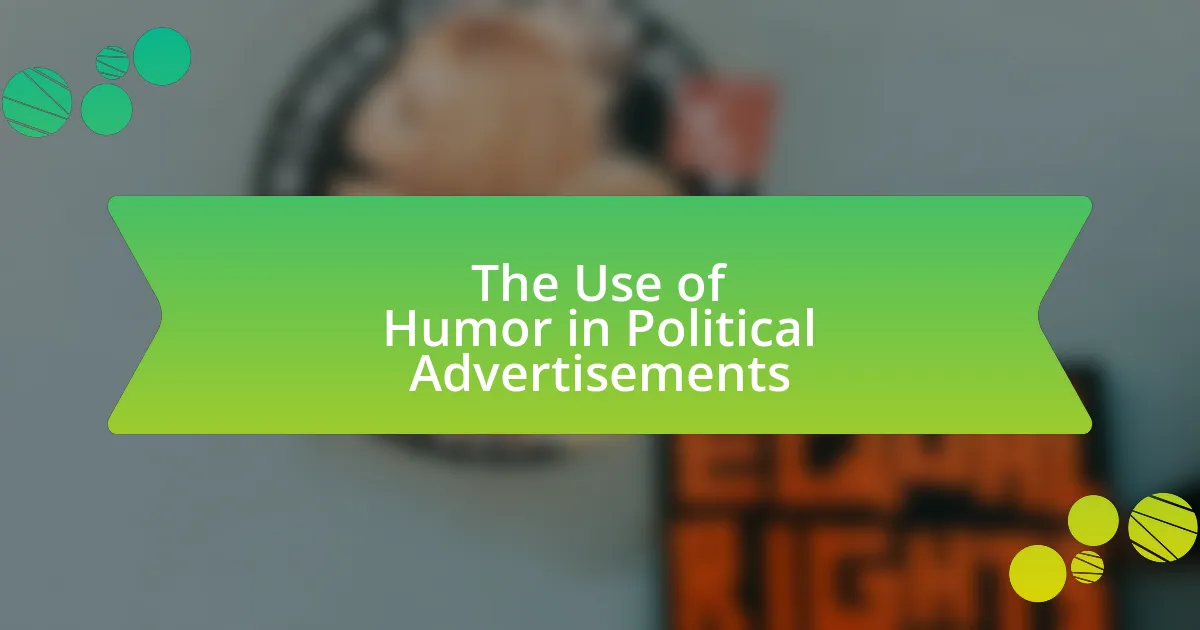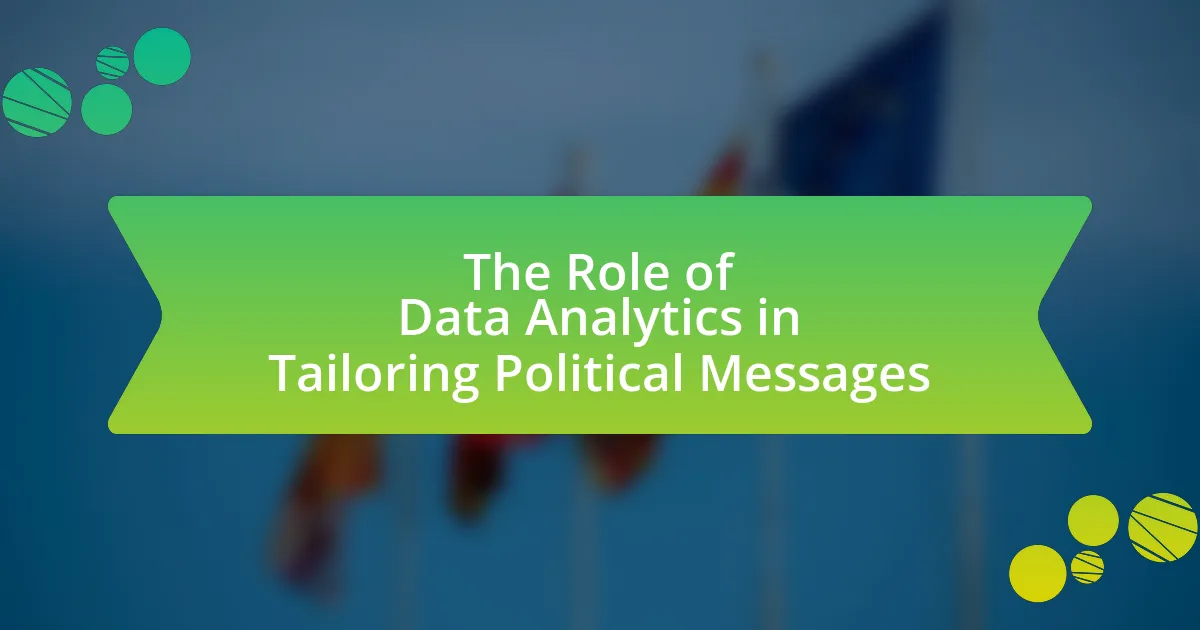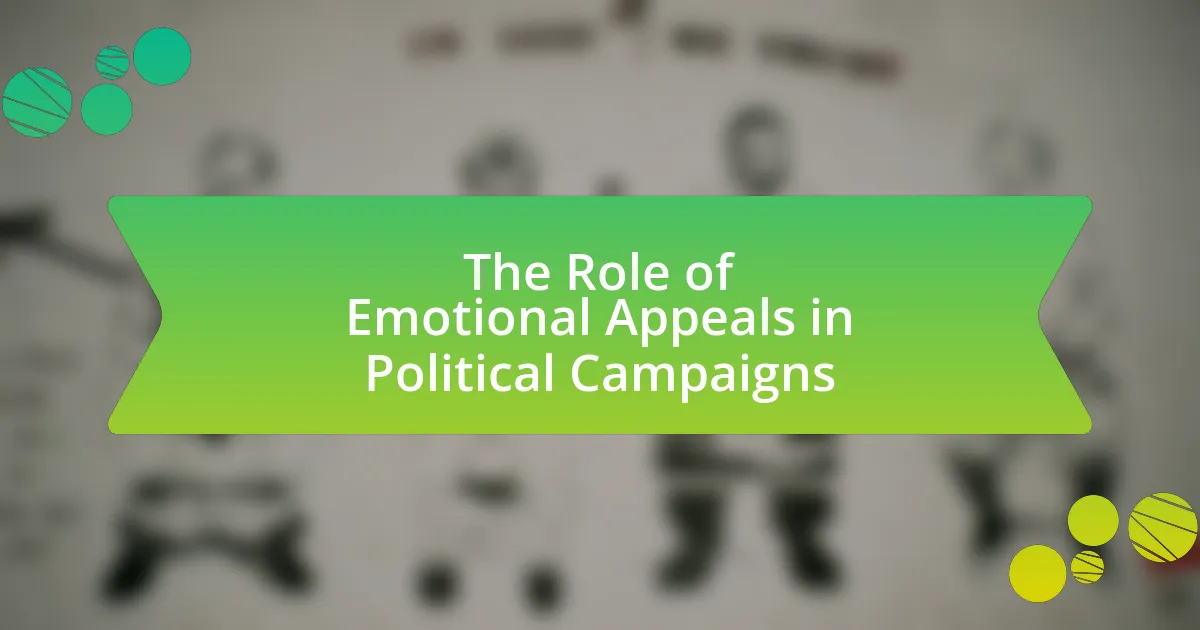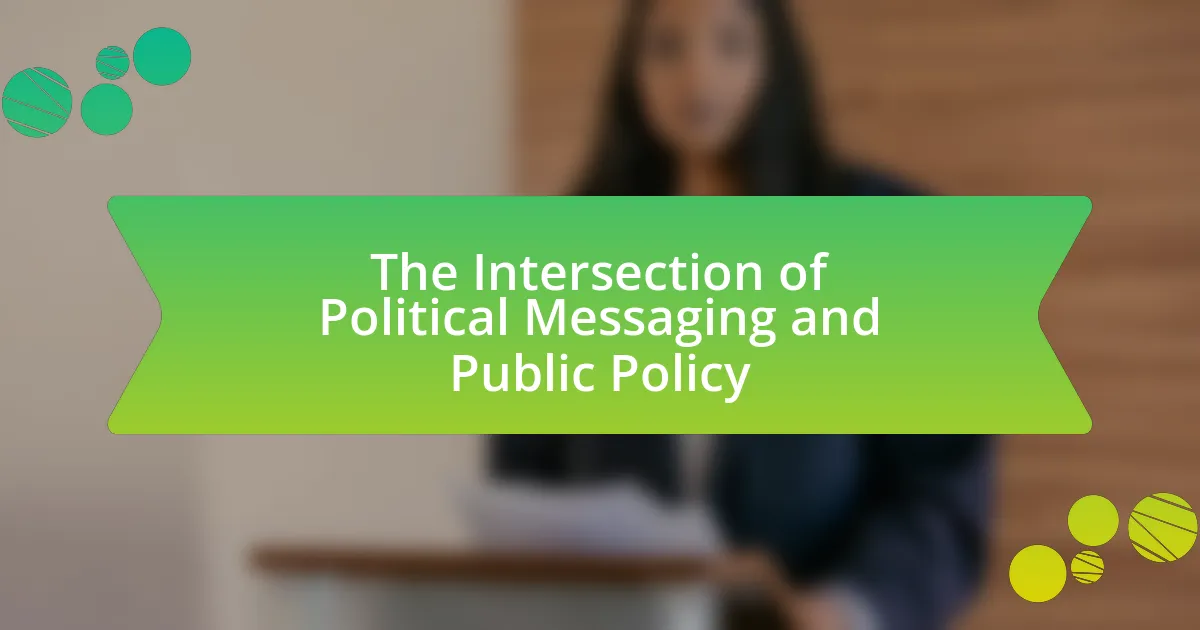The article analyzes the impact of social media on political messaging, highlighting its role in the rapid dissemination of information and direct engagement between politicians and voters. It discusses how platforms like Twitter and Facebook have transformed political communication, emphasizing features such as user-generated content, real-time interaction, and targeted advertising that influence voter behavior and public opinion. The article also examines the challenges posed by misinformation, the ethical considerations in political messaging, and the strategies employed by political campaigns to effectively utilize social media. Additionally, it addresses the consequences of social media on political polarization and voter engagement, providing insights into the tools and best practices for analyzing the effectiveness of political messaging in the digital landscape.
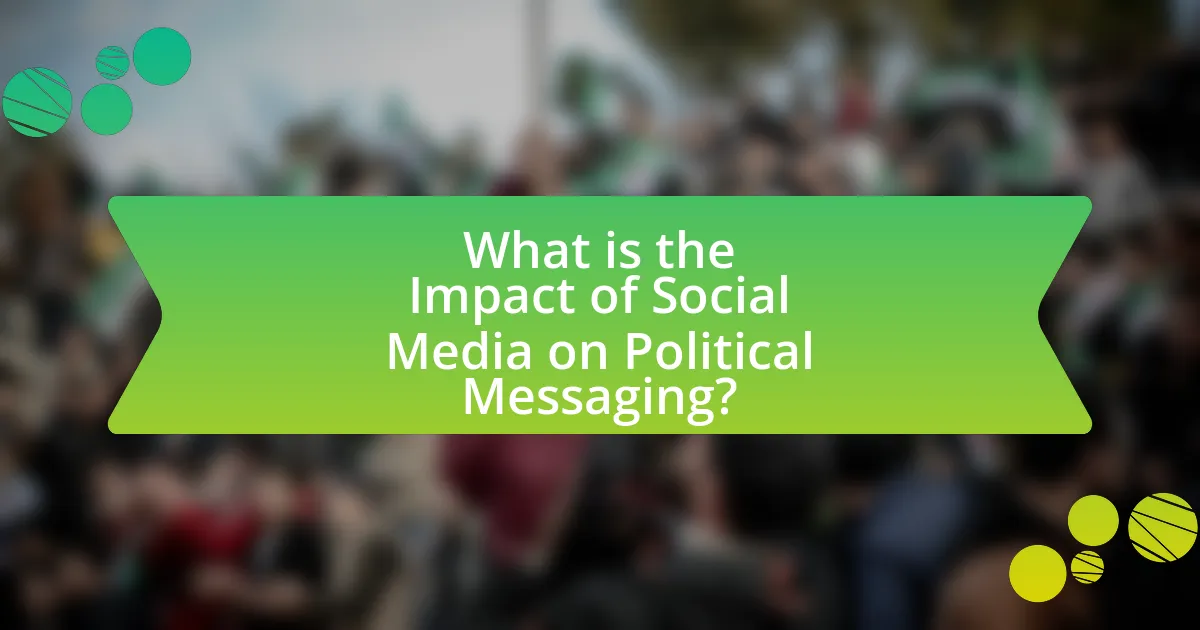
What is the Impact of Social Media on Political Messaging?
The impact of social media on political messaging is profound, as it enables rapid dissemination of information and facilitates direct engagement between politicians and the electorate. Social media platforms like Twitter and Facebook allow political messages to reach vast audiences instantly, often bypassing traditional media filters. For instance, during the 2016 U.S. presidential election, over 60% of voters reported using social media as a primary source of news, highlighting its role in shaping public opinion. Furthermore, social media’s algorithms can amplify certain messages, creating echo chambers that reinforce existing beliefs, which can significantly influence voter behavior and political polarization.
How has social media transformed political communication?
Social media has transformed political communication by enabling direct interaction between politicians and the public, bypassing traditional media filters. This shift allows for real-time engagement, where political messages can be disseminated instantly and feedback can be received immediately. For instance, platforms like Twitter and Facebook have been used by politicians to announce policies, respond to criticism, and mobilize supporters, significantly altering the dynamics of political discourse. According to a Pew Research Center study, 69% of adults in the U.S. use social media, which highlights its role as a primary source of news and information, further emphasizing its impact on how political messages are crafted and consumed.
What are the key features of social media that influence political messaging?
The key features of social media that influence political messaging include user-generated content, real-time communication, targeted advertising, and network effects. User-generated content allows individuals to share opinions and information, shaping public discourse and enabling grassroots movements. Real-time communication facilitates immediate responses to political events, allowing messages to spread rapidly and influence public perception. Targeted advertising enables political campaigns to reach specific demographics based on user data, increasing the effectiveness of messaging. Network effects amplify the reach of political messages as users share content within their social circles, creating viral trends that can significantly impact political outcomes. These features collectively enhance the ability of political actors to engage with the electorate and shape political narratives.
How do different social media platforms affect political discourse?
Different social media platforms significantly affect political discourse by shaping how information is disseminated and consumed. For instance, Twitter’s character limit encourages brevity and rapid sharing, which can lead to the spread of soundbites and polarizing content, as evidenced by the platform’s role in the 2016 U.S. presidential election where tweets often influenced public opinion and media coverage. In contrast, Facebook’s algorithm prioritizes content that generates engagement, which can create echo chambers where users are exposed primarily to viewpoints that reinforce their existing beliefs, as shown in research by the Pew Research Center indicating that 62% of Americans get news from social media, often leading to increased political polarization. Additionally, platforms like TikTok engage younger audiences through creative content, potentially altering traditional political messaging by emphasizing visual storytelling over text-based discourse. These dynamics illustrate how the unique features of each platform can influence the nature and quality of political discussions.
Why is understanding this impact important for voters?
Understanding the impact of social media on political messaging is crucial for voters because it shapes their perceptions and decisions. Social media platforms significantly influence how political information is disseminated, often prioritizing sensational content that can distort reality. For instance, a study by the Pew Research Center found that 64% of Americans believe that social media has a major impact on their political views. This highlights the necessity for voters to critically evaluate the information they encounter online, as misinformation can lead to misguided voting choices.
How does social media shape public opinion during elections?
Social media shapes public opinion during elections by facilitating rapid information dissemination and enabling direct engagement between candidates and voters. Platforms like Twitter and Facebook allow political messages to reach large audiences quickly, influencing perceptions and attitudes. For instance, a study by the Pew Research Center found that 69% of adults in the U.S. use social media, making it a critical space for political discourse. Additionally, social media algorithms often prioritize emotionally charged content, which can amplify polarizing views and create echo chambers, further impacting voter opinions.
What role does misinformation play in political messaging on social media?
Misinformation significantly influences political messaging on social media by shaping public perception and voter behavior. It spreads rapidly due to the viral nature of social media platforms, where false narratives can reach millions in a short time. For instance, a study by the Massachusetts Institute of Technology found that false news stories are 70% more likely to be retweeted than true stories, highlighting the potency of misinformation in swaying opinions. This manipulation can lead to polarization, as individuals may align with misleading information that reinforces their existing beliefs, ultimately affecting electoral outcomes and democratic processes.
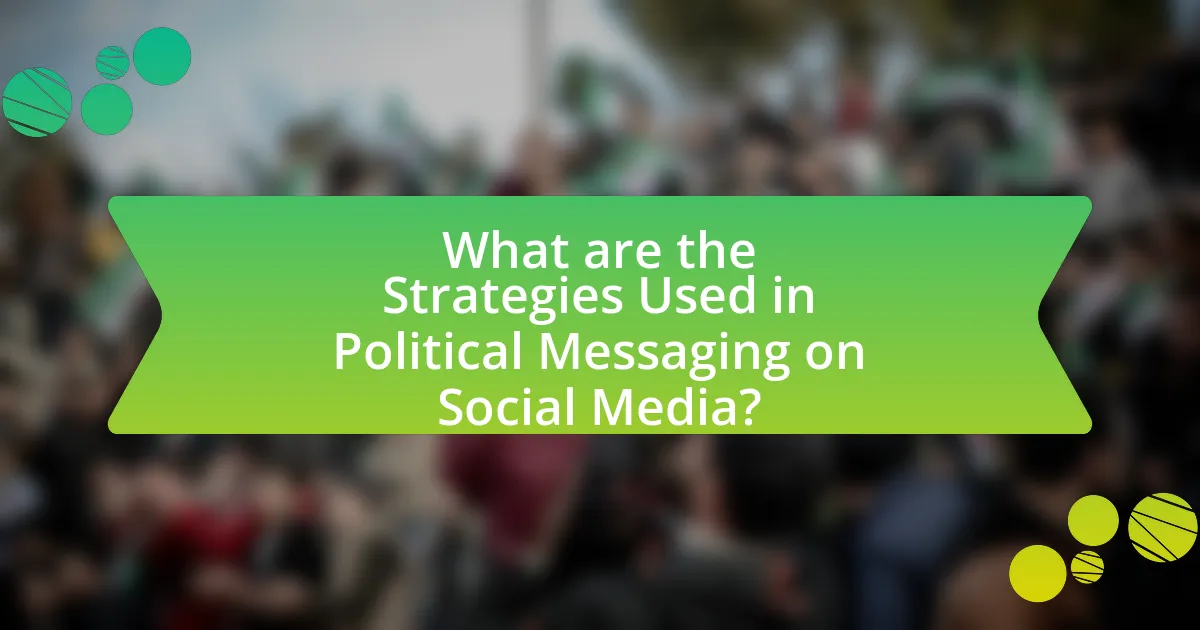
What are the Strategies Used in Political Messaging on Social Media?
Political messaging on social media employs several key strategies, including targeted advertising, emotional appeals, and the use of influencers. Targeted advertising allows political campaigns to reach specific demographics based on data analytics, enhancing the effectiveness of their messages. Emotional appeals are crafted to resonate with voters’ feelings, often utilizing storytelling to create a connection. The use of influencers leverages their established credibility and reach to amplify political messages, making them more relatable to younger audiences. These strategies are supported by research indicating that targeted ads can increase voter engagement by up to 50%, while emotional content is more likely to be shared, thus broadening the message’s reach.
How do political campaigns utilize social media effectively?
Political campaigns utilize social media effectively by engaging directly with voters, disseminating targeted messages, and fostering community interaction. Campaigns leverage platforms like Facebook, Twitter, and Instagram to create personalized content that resonates with specific demographics, enhancing voter outreach. For instance, during the 2020 U.S. presidential election, Joe Biden’s campaign utilized targeted ads on social media, reaching over 100 million users, which significantly contributed to voter mobilization. Additionally, social media allows for real-time feedback and interaction, enabling campaigns to adjust their strategies based on public sentiment and engagement metrics. This dynamic approach not only amplifies campaign messages but also builds a sense of community among supporters, ultimately influencing voter behavior and election outcomes.
What types of content are most engaging for political messaging?
Visual content, such as videos and infographics, is the most engaging for political messaging. Research indicates that posts with images or videos receive 94% more views than text-only posts, making them significantly more effective in capturing audience attention. Additionally, emotionally charged content, including personal stories and testimonials, tends to resonate more with viewers, leading to higher engagement rates. A study by the Pew Research Center found that 64% of Americans believe that social media has a significant impact on political discourse, highlighting the importance of engaging content in shaping public opinion.
How do political figures leverage personal branding on social media?
Political figures leverage personal branding on social media by curating their online personas to connect with constituents and shape public perception. They utilize platforms like Twitter, Facebook, and Instagram to share personal stories, engage in direct communication, and promote their political agendas, thereby fostering a sense of authenticity and relatability. For instance, during the 2020 U.S. presidential election, candidates like Joe Biden and Donald Trump effectively used social media to disseminate their messages, mobilize supporters, and respond to opponents in real-time, demonstrating the power of personal branding in influencing voter behavior and engagement.
What are the ethical considerations in political messaging on social media?
Ethical considerations in political messaging on social media include truthfulness, transparency, and the potential for manipulation. Political entities must ensure that their messages are factually accurate to avoid spreading misinformation, which can mislead voters and distort democratic processes. Transparency about funding sources and the origins of information is crucial, as it fosters trust and accountability. Additionally, the use of targeted advertising and algorithms raises concerns about manipulation, as it can create echo chambers and reinforce biases, ultimately undermining informed decision-making. Research by the Pew Research Center indicates that 64% of Americans believe that social media has a mostly negative effect on the way things are going in the country today, highlighting the need for ethical standards in political messaging.
How do privacy concerns affect political messaging strategies?
Privacy concerns significantly influence political messaging strategies by prompting campaigns to adopt more transparent and ethical data practices. As voters become increasingly aware of data privacy issues, political entities must navigate these concerns to maintain trust and credibility. For instance, the Cambridge Analytica scandal in 2016 highlighted the risks associated with data misuse, leading to heightened scrutiny of how campaigns collect and utilize personal information. Consequently, political messaging strategies now often emphasize consent and data protection, focusing on building relationships with constituents based on trust rather than invasive targeting. This shift is evident in the adoption of privacy-centric platforms and messaging that reassures voters about their data security, ultimately shaping the effectiveness and reception of political communications.
What regulations exist to govern political advertising on social media?
Regulations governing political advertising on social media include the Federal Election Commission (FEC) rules in the United States, which require disclosure of the source of funding for political ads and mandate that platforms maintain a public database of such advertisements. Additionally, the Honest Ads Act proposes stricter transparency requirements for online political ads, similar to those for television and radio. In the European Union, the Audiovisual Media Services Directive (AVMSD) regulates political advertising, emphasizing transparency and accountability. These regulations aim to combat misinformation and ensure that users are aware of the origins of political content.
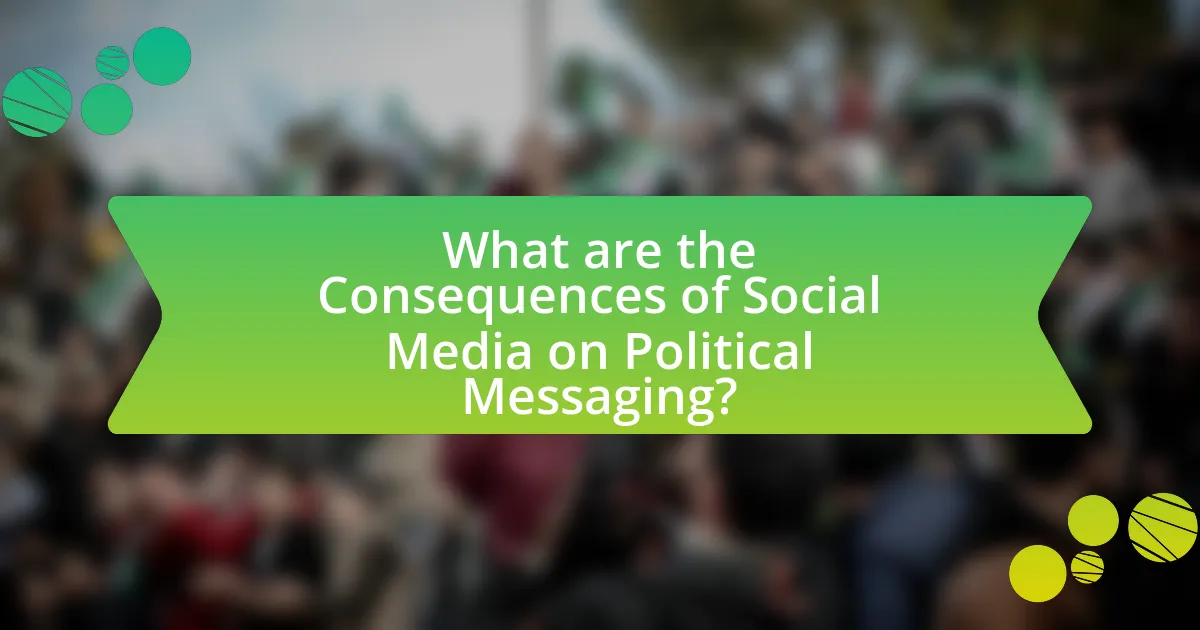
What are the Consequences of Social Media on Political Messaging?
Social media significantly alters political messaging by enabling rapid dissemination of information and fostering direct engagement between politicians and the electorate. This shift allows for real-time communication, which can amplify political messages and mobilize supporters quickly, as evidenced by the use of platforms like Twitter during the Arab Spring, where activists utilized social media to organize protests and share information widely. Additionally, social media can create echo chambers, where users are exposed primarily to viewpoints that reinforce their existing beliefs, potentially polarizing political discourse. Research from the Pew Research Center indicates that 62% of Americans get news from social media, highlighting its role in shaping public opinion and political narratives.
How does social media influence voter behavior?
Social media significantly influences voter behavior by shaping perceptions, facilitating information dissemination, and enhancing political engagement. Platforms like Facebook and Twitter allow candidates to communicate directly with voters, bypassing traditional media filters, which can lead to increased voter mobilization. For instance, a study by the Pew Research Center found that 69% of adults in the U.S. use social media, and among those, 20% reported that they had engaged with political content, indicating a direct correlation between social media use and political awareness. Furthermore, targeted advertising on these platforms can sway undecided voters by presenting tailored messages that resonate with their specific interests and concerns, thereby impacting their voting decisions.
What evidence exists linking social media use to electoral outcomes?
Evidence linking social media use to electoral outcomes includes studies demonstrating that increased social media engagement correlates with higher voter turnout and influence on public opinion. For instance, research by the Pew Research Center indicates that 69% of adults in the U.S. use social media, and those who engage with political content are more likely to participate in elections. Additionally, a study published in the journal “Political Communication” found that social media campaigns significantly impacted voter mobilization efforts during the 2016 U.S. presidential election, with targeted ads on platforms like Facebook leading to increased voter engagement. These findings illustrate a clear connection between social media activity and electoral participation.
How do social media campaigns impact political polarization?
Social media campaigns significantly contribute to political polarization by facilitating echo chambers and reinforcing existing beliefs. Research indicates that algorithms prioritize content that aligns with users’ preferences, leading to the consumption of homogeneous viewpoints. A study by the Pew Research Center found that 62% of social media users encounter mostly like-minded opinions, which can intensify partisan divides. Additionally, targeted political ads exploit user data to amplify divisive messages, further entrenching ideological divides. This dynamic creates an environment where individuals are less likely to engage with opposing perspectives, thereby exacerbating political polarization.
What are the challenges faced by political communicators on social media?
Political communicators face several challenges on social media, including misinformation, audience fragmentation, and the rapid pace of information dissemination. Misinformation can undermine credibility and distort public perception, as seen during election cycles where false narratives spread quickly. Audience fragmentation complicates messaging, as different demographics engage with varied platforms and content styles, making it difficult to create a unified message. Additionally, the rapid pace of information flow requires communicators to respond swiftly, often leading to hasty decisions that may not align with strategic goals. These challenges necessitate careful navigation to maintain effective political messaging in a complex digital landscape.
How do algorithms affect the visibility of political messages?
Algorithms significantly influence the visibility of political messages by determining which content is prioritized in users’ feeds. These algorithms analyze user behavior, engagement patterns, and preferences to curate content, often favoring posts that generate higher interaction rates. For instance, a study by the Pew Research Center found that 64% of Americans believe social media platforms have a significant impact on the way political information is shared and consumed. This prioritization can lead to echo chambers, where users are predominantly exposed to messages that align with their existing beliefs, thereby shaping public opinion and political discourse.
What strategies can mitigate the spread of misinformation?
To mitigate the spread of misinformation, implementing fact-checking initiatives is essential. Fact-checking organizations, such as Snopes and FactCheck.org, actively verify claims and provide accurate information, which helps counter false narratives. Additionally, promoting media literacy among users enables individuals to critically evaluate sources and discern credible information from misleading content. Research indicates that media literacy programs can significantly reduce susceptibility to misinformation, as evidenced by a study published in the Journal of Communication, which found that participants exposed to media literacy training were less likely to believe false information. Furthermore, social media platforms can enhance their algorithms to prioritize credible sources and flag misleading content, as seen in Facebook’s efforts to reduce misinformation through partnerships with fact-checkers. These strategies collectively contribute to a more informed public and a reduction in the dissemination of false information.
What best practices should political communicators follow on social media?
Political communicators should prioritize transparency, engagement, and authenticity on social media. Transparency involves openly sharing information and being honest about intentions, which builds trust with the audience. Engagement requires actively interacting with followers, responding to comments, and participating in discussions to foster a sense of community. Authenticity is crucial; communicators should present genuine messages that reflect their values and beliefs, as studies show that authentic communication resonates more with audiences, leading to increased support and loyalty. For instance, a 2020 study by the Pew Research Center found that 70% of social media users prefer content that feels real and relatable over polished, professional messaging.
How can political messages be crafted to resonate with diverse audiences?
Political messages can be crafted to resonate with diverse audiences by employing targeted communication strategies that consider cultural, social, and demographic factors. Tailoring messages to reflect the values, beliefs, and experiences of specific groups enhances relatability and engagement. For instance, research by the Pew Research Center indicates that individuals are more likely to respond positively to political content that aligns with their personal experiences and community issues. Additionally, utilizing various platforms and formats, such as videos, infographics, and interactive content, can cater to different preferences and increase accessibility. This approach not only broadens the reach of political messages but also fosters a sense of inclusion among varied audience segments.
What tools can be used to analyze the effectiveness of political messaging on social media?
Tools that can be used to analyze the effectiveness of political messaging on social media include sentiment analysis software, social media analytics platforms, and A/B testing tools. Sentiment analysis software, such as Brandwatch or Lexalytics, evaluates public sentiment towards political messages by analyzing user-generated content. Social media analytics platforms like Hootsuite and Sprout Social provide insights into engagement metrics, audience demographics, and content performance, allowing for a comprehensive understanding of how messages resonate with users. A/B testing tools, such as Optimizely, enable political campaigns to test different messaging strategies and measure their impact on user engagement and conversion rates. These tools collectively offer data-driven insights that can validate the effectiveness of political messaging strategies on social media.
